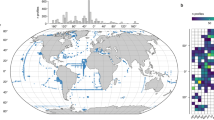Abstract
WHETHER or not life can exist far from the open sea beneath the permanent ice shelves of Antarctica is not known, but there are three opinions. (1) A biota cannot exist at all because of the absence of surface primary and secondary productivity1. (2) A biota exists but with specialisations unique to life in the absence of surface productivity and in isolation under an ice shelf1. (3) A typical Antarctic biota exists under any Antarctic ice shelf because currents are surely present that could carry food to it2. Evidence supporting any of these views is unreliable. On the Ross Ice Shelf, samples taken through cracks 22 and 28 km from the open sea and in a newly calved area 8 km from the former ice front yielded rich benthic faunas but no floras3,4. Plant life was presumably restricted by the lack of light coming through the ice. Some of the more common species of animals at nearby McMurdo Sound were not found in the samples, indicating that there was a possibility that conditions under the ice precluded them. Such differences, however, are common in Antarctic shallow-water areas, and can be due to local substrate differences, recent grounding of ice, or sampling bias dependent on the size and penetration depth of the sampler5. The Ross Ice Shelf locations are so close to the open ocean that typical benthic communities might live there. At George VI Sound, marine fish whose stomachs contained several species of invertebrates were caught through a proglacial lake adjacent to the ice shelf 100km from the nearest open water6. These animals were interpreted as evidence that a marine biome occurs under the entire shelf6. However, we describe here a microbiota from the George VI Sound occurrence that indicates that the fauna there may also be unique because it resides in a situation not typical of the entire ice shelf. Available evidence thus does not support any opinion.
This is a preview of subscription content, access via your institution
Access options
Subscribe to this journal
Receive 51 print issues and online access
$199.00 per year
only $3.90 per issue
Buy this article
- Purchase on Springer Link
- Instant access to full article PDF
Prices may be subject to local taxes which are calculated during checkout
Similar content being viewed by others
References
Zumberge, J. H., Antarct. J. U.S., 6, 258 (1971).
Arnaud, P. M., Nature, 256, 521 (1975).
Littlepage, J. L., and Pearse, J. S., Science, 137, 679 (1962).
McWhinnie, M. A., Antarct. J. U.S., 7, 59 (1972).
DeLaca, T. E., and Lipps, J. H., Antarct. J. U.S., 11, 12 (1976).
Heywood, R. B., and Light, J. J., Nature, 254, 591 (1975).
Swithinbank, C., Polar Rec., 17, 155 (1974).
Smith, B. M. E., Sci. Rep. Br. Antarct. Surv., 72, 1 (1972).
Krebs, W. N., Antarct. J. U.S., 8, 307 (1973).
Barrett, P. J., Nature, 256, 390 (1975).
Author information
Authors and Affiliations
Rights and permissions
About this article
Cite this article
LIPPS, J., KREBS, W. & TEMNIKOW, N. Microbiota under Antarctic ice shelves. Nature 265, 232–233 (1977). https://doi.org/10.1038/265232a0
Received:
Accepted:
Issue Date:
DOI: https://doi.org/10.1038/265232a0
Comments
By submitting a comment you agree to abide by our Terms and Community Guidelines. If you find something abusive or that does not comply with our terms or guidelines please flag it as inappropriate.



